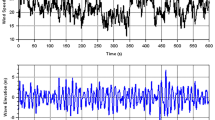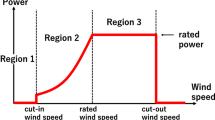Abstract
This paper evaluates the performance of a linear quadratic (LQ) optimal controller designed for a spar buoy floating offshore wind turbine (FOWT) considering different wind turbulence conditions. To account for the uncertainty in offshore wind turbulence intensity (TI), three levels of TI are adopted in the above rated wind speed region. The TI levels of 15%, 11% and 5% are based on an international standard for wind turbine design, measurements from the Hywind Demo FOWT, and long-term measurements from an offshore wind research platform, respectively. The control objectives are improved rotor speed/power regulation and floater pitch motion reduction, compared with a detuned proportional-integral (PI) controller, using collective blade pitch actuation. A two-dimensional modeling approach is adopted for LQ controller design, according to previous verification based on an available wind turbine simulator, assuming aligned wind and waves. The controller tuning is based on wind/wave disturbance models in the time domain. Simulations carried out for the reference OC3-Hywind spar FOWT exposed to the adopted TI levels of 15%, 11% and 5%, in rough sea state, show that the designed LQ controller can yield rotor speed/power variation reduction of approximately 55%, 46% and 12%, respectively, and floater pitch angle reduction of approximately 38%, 32% and 14%, respectively, with acceptable increase in the actuator activity, compared with the baseline PI controller. These results demonstrate that LQ design with suitable tuning can improve the control performance of a spar buoy FOWT in the presence of TI uncertainty.






Similar content being viewed by others
References
R.LC.B. Ramos, Effect of offshore turbulence on the control of spar buoy floating wind turbines, in Proceedings of the SOBENA 28th International Congress on Waterborne Transportation, Shipbuilding and Offshore Constructions (SOBENA 2020), Rio de Janeiro, Brazil, October 26–29 (2020). https://doi.org/https://doi.org/10.17648/sobena-2020-122813
World Bank Group. Offshore wind technical potential in Brazil (2020)
World Bank Group. Going global: expanding offshore wind to emerging markets (2019)
M. Karimirad, Stochastic dynamic response analysis of spar-type wind turbines with catenary or taut mooring systems. Doctoral Thesis, NTNU, Trondheim, Norway (2011)
DNV GL, Standard DNVGL-ST-0119: Floating wind turbine structures (2018)
E.A. Bossanyi, G. Ramtharan, B. Savini, The importance of control in wind turbine design and loading, in Proceedings of the 17th IEEE Mediterranean Conference on Control & Automation, June 24–26, Thessaloniki, Greece (2009). https://doi.org/https://doi.org/10.1109/MED.2009.5164721
T.J. Larsen, T.D. Hanson, A method to avoid negative damped low frequent tower vibrations for a floating, pitch controlled wind turbine. The Science of making torque from wind. J, Phys. 75(012073), 1–11 (2007). https://doi.org/10.1088/1742-6596/75/1/012073
J.M. Jonkman, Influence of control on the pitch damping of a floating wind turbine. Conference Paper NREL/CP-500–42589. Natl. Renew. Energy Lab. (2008)
O. Bagherieh, R. Nagamune, Gain-scheduling control of a floating offshore wind turbine above rated wind speed. Control Theory Technol. 13(2), 160–172 (2015). https://doi.org/10.1007/s11768-015-4152-0
S. Christiansen, T. Knudsen, T. Bak, Optimal control of a ballast-stabilized floating wind turbine, in Proceedings of IEEE International Symposium on Computer-Aided Control System Design (CACSD), Denver, CO, USA (2011). https://doi.org/https://doi.org/10.1109/CACSD.2011.6044574
F. Lemmer, Low-order modeling, control design and optimization of floating offshore wind turbines. Doctor of Engineering Sciences Thesis, University of Stuttgart, Germany (2018)
F. Lemmer, D. Schlipf, P.W. Cheng, Control design methods for floating wind turbines for optimal disturbance rejection. The science of making torque from wind. J. Phys. 753(092006), 1–14 (2016). https://doi.org/10.1088/1742-6596/753/9/092006
E. Lindeberg, Optimal control of floating offshore wind turbines. Master of Science Thesis, NTNU, Trondheim, Norway (2009)
H. Namik, K. Stol, Individual blade pitch control of a spar-buoy floating wind turbine. IEEE Trans. Cont. Sys. Tech. 22(1), 214–223 (2014). https://doi.org/10.1109/TCST.2013.2251636
R.L. Ramos, Linear quadratic optimal control of a spar-type floating offshore wind turbine in the presence of turbulent wind and different sea states. J. Mar. Sci. Eng. 6(4), 151 (2018). https://doi.org/10.3390/jmse6040151
Z. Wu, Y. Li, Platform stabilization and load reduction of floating offshore wind turbines with tension-leg platform using dynamic vibration absorbers. Wind Energy 23(3), 711–730 (2020). https://doi.org/10.1002/we.2453
DNV GL, Standard DNVGL-ST-0437: Loads and site conditions for wind turbines (2016)
International Electrotechnical Commission (IEC), International Standard IEC 61400–3: Wind turbines—Part 3: Design requirements for offshore wind turbines, Geneva, Switzerland (2009)
International Electrotechnical Commission (IEC), International Standard IEC 61400–1: Wind turbines—Part 1: Design requirements, Geneva, Switzerland (2005)
N. Bodini, J.K. Lundquist, A. Kirincich, Offshore wind turbines will encounter very low atmospheric turbulence. J. Phys. 1452(012023), 1–7 (2020). https://doi.org/10.1088/1742-6596/1452/1/012023
S. Emeis, Current issues in wind energy meteorology. Meteorol. Appl. 21(4), 803–819 (2014). https://doi.org/10.1002/met.1472
B. Ernst, J.R. Seume, Investigation of site-specific wind field parameters and their effect on loads of offshore wind turbines. Energies 5(10), 3835–3855 (2012). https://doi.org/10.3390/en5103835
C. Hübler, C.G. Gebhardt, R. Rolfes, Development of a comprehensive database of scattering environmental conditions and simulation constraints for offshore wind turbines. Wind Energy Sci. 2, 491–505 (2017). https://doi.org/10.5194/wes-2-491-2017
A. Nybø, F.G. Nielsen, J. Reuder, Processing of sonic anemometer measurements for offshore wind applications. J. Phys. 1356(012006), 1–13 (2019). https://doi.org/10.1088/1742-6596/1356/1/012006
A. Nybø, F.G. Nielsen, J. Reuder, M.J. Churchfield, M. Godvik, Evaluation of different wind fields for the investigation of the dynamic response of offshore wind turbines. Wind Energy 23(9), 1810–1830 (2020). https://doi.org/10.1002/we.2518
P.A. Fleming, A. Peiffer, D. Schlipf, Wind turbine controller to mitigate structural loads on a floating wind turbine platform, in Proceedings of the ASME 35th International Conference on Ocean, Offshore and Arctic Engineering (OMAE 2016), Busan, Korea, June 19–24 (2016). https://doi.org/https://doi.org/10.1115/OMAE2016-54536
S. Caires, J.J. Schouten, L. Lonseth, V. Neshaug, I. Pathirana, O. Storas, Uncertainties in offshore wind turbulence intensity. J. Phys. 1356(012037), 1–12 (2019). https://doi.org/10.1088/1742-6596/1356/1/012037
G.C. Larsen, K. Ronold, H.E. Jørgensen, K. Argyriadis, J. D. Boer. Ultimate loading of wind turbines. Risø National Laboratory, Risø-R, No. 1111 (EN), Roskilde, DTU Library, Denmark (1999).
P.J. Moriarty, W.E. Holley, S. Butterfield, Effect of turbulence variation on extreme loads prediction for wind turbines. J. Sol. Energy Eng. 124(4), 387–395 (2002). https://doi.org/10.1115/1.1510137
B.D.O. Anderson, J.B. Moore, Optimal Control: Linear Quadratic Methods (Dover, New York, 2007).
G. Betti, M. Farina, G.A. Guagliardi, A. Marzorati, R. Scattolini, Development of a control-oriented model of floating wind turbines. IEEE Trans. Cont. Sys. Tech. 22(1), 69–82 (2014). https://doi.org/10.1109/TCST.2013.2242073
A. Fontanella, I. Bayati, M. Belloli, Linear coupled model for floating wind turbine control. Wind Eng. 42(2), 115–127 (2018). https://doi.org/10.1177/0309524X18756970
V. Nava, H. Bagbanci, C. Guedes Soares, F. Arena, On the response of a spar floating wind turbine under the occurrence of extreme events, in Proceedings of the ASME 32nd International Conference on Ocean, Offshore and Arctic Engineering (OMAE 2013), Nantes, France, June 9–14 (2013). https://doi.org/https://doi.org/10.1115/OMAE2013-11140
F. Lemmer, K. Müller, A. Pegalajar-Jurado, M. Borg, H. Bredmose, LIFES50+ D4.1: Simple numerical models for upscaled design. University of Stuttgart, Germany, and DTU Wind Energy, Denmark (2016)
N. Johnson, J. Jonkman, A. Wright, G. Hayman, A. Robertson, Verification of floating offshore wind linearization functionality in OpenFAST. J. Phys. 1356(012022), 1–23 (2019). https://doi.org/10.1088/1742-6596/1356/1/012022
J.M. Jonkman, M.L. Buhl Jr., FAST user’s guide. Technical Report NREL/TP-500–38230. Natl. Renew. Energy Lab. (2005)
M. Shan, Load Reducing Control for Wind Turbines: Load Estimation and Higher Level Controller Tuning Based on Disturbance Spectra and Linear Models (Fraunhofer Verlag, Germany, 2018).
J.M. Jonkman, S. Butterfield, W. Musial, G. Scott, Definition of a 5-MW reference wind turbine for offshore system development. Technical Report NREL/TP-500–38060. Natl. Renew. Energy Lab. (2009)
J.M. Jonkman, Definition of the floating system for phase IV of OC3. Technical Report NREL/TP-500–47535. Natl. Renew. Energy Lab. (2010)
D. Schlipf, E. Simley, F. Lemmer, L. Pao, P.W. Cheng, Collective pitch feedforward control of floating wind turbines using lidar. J. Ocean Wind Energy 2(4), 223–230 (2015). https://doi.org/10.17736/jowe.2015.arr04
M. Al, A. Fontanella, D. van der Hoek, Y. Liu, M. Belloli, J.W. van Wingerden, Feedforward control for wave disturbance rejection on floating offshore wind turbines. J. Phys. 1618(022048), 1–10 (2020). https://doi.org/10.1088/1742-6596/1618/2/022048
L. Landberg, Meteorology for Wind Energy: An Introduction (Wiley, UK, 2015).
B. Skaare, F.G. Nielsen, T.D. Hanson, R. Yttervik, O. Havmøller, A. Rekdal, Analysis of measurements and simulations from the Hywind Demo floating wind turbine. Wind Energy 18(6), 1105–1122 (2015). https://doi.org/10.1002/we.1750
F.D. Bianchi, H.D. Battista, R.J. Mantz, Wind Turbine Control Systems: Principles, Modeling and Gain Scheduling Design (Springer, London, 2007).
S.K. Chakrabarti, Handbook of Offshore Engineering (Elsevier, Amsterdam, 2005).
F. Driscoll, J. Jonkman, A. Robertson, S. Sirnivas, B. Skaare, F.G. Nielsen, Validation of a FAST model of the Statoil-Hywind Demo floating wind turbine. Energy Procedia 94, 3–19 (2016). https://doi.org/10.1016/j.egypro.2016.09.181
M. Karimirad, T. Moan, A simplified method for coupled analysis of floating offshore wind turbines. Mar. Struct. 27, 45–63 (2012). https://doi.org/10.1016/j.marstruc.2012.03.003
J.M.J. Journée, W.W. Massie, Offshore Hydromechanics (Delft University of Technology, Delft, 2001).
T.I. Fossen, Handbook of Marine Craft Hydrodynamics and Motion Control (Wiley, UK, 2011).
C.L. Bottasso, A. Croce, Power curve tracking with tip speed constraint using LQR regulators. Scientific Report DIA-SR 09–04, Politecnico di Milano (2009)
B. Fischer, Reducing rotor speed variations of floating wind turbines by compensation of non-minimum phase zeros, in Proceedings of the European Wind Energy Association Annual Event (EWEA 2012), Copenhagen, Denmark (2012).
H. Suzuki, A. Sato, Load on turbine blade induced by motion of floating platform and design requirement for the platform, in Proceedings of the 26th International Conference on Offshore Mechanics and Arctic Engineering (OMAE 2007), San Diego, California, USA, June 10–15 (2007). https://doi.org/https://doi.org/10.1115/OMAE2007-29500
M.S. Siddiqui, A. Rasheed, T. Kvamsdal, M. Tabib, Effect of turbulence intensity on the performance of an offshore vertical axis wind turbine. Energy Procedia 80, 312–320 (2015). https://doi.org/10.1016/j.egypro.2015.11.435
R. Siavashi, Sensitivity analysis of the dynamic response of floating wind turbines. Master Thesis, Geophysical Institute, University of Bergen, Bergen, Norway (2018)
L. Li, Y. Liu, Z. Yuan, Y. Gao, Dynamic and structural performances of offshore floating wind turbines in turbulent wind flow. Ocean Eng. 179, 92–103 (2019). https://doi.org/10.1016/j.oceaneng.2019.03.028
Funding
Not applicable.
Author information
Authors and Affiliations
Corresponding author
Ethics declarations
Conflict of interest
Not applicable.
Additional information
Publisher's Note
Springer Nature remains neutral with regard to jurisdictional claims in published maps and institutional affiliations.
Rights and permissions
About this article
Cite this article
da Cunha Barroso Ramos, R.L. Effect of turbulence intensity on the linear quadratic control of spar buoy floating wind turbines. Mar Syst Ocean Technol 16, 84–98 (2021). https://doi.org/10.1007/s40868-021-00098-4
Received:
Accepted:
Published:
Issue Date:
DOI: https://doi.org/10.1007/s40868-021-00098-4




